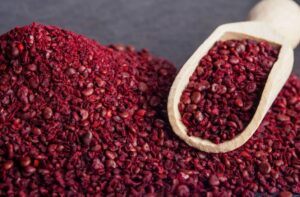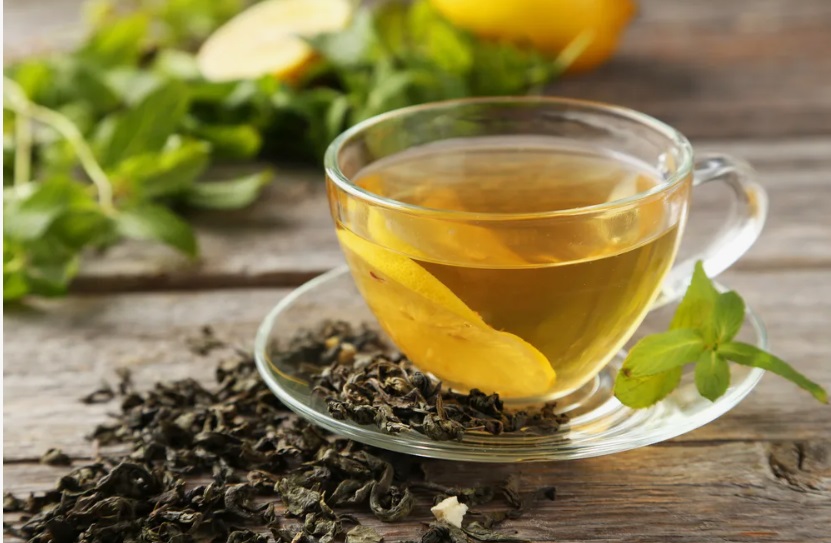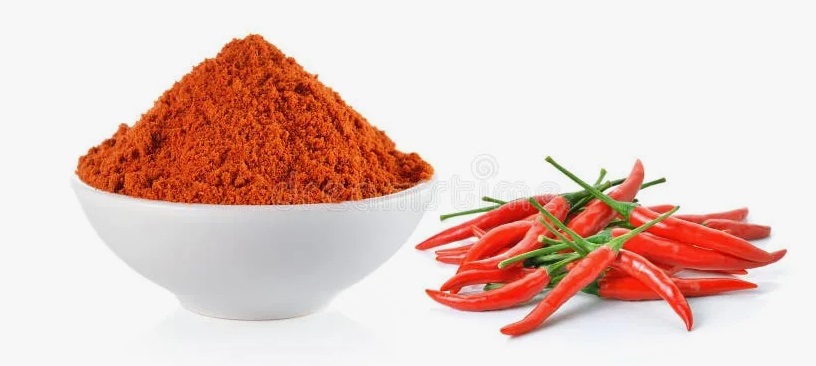What is Sumac and Where Does It Grow?
Sumac is a vibrant, crimson-colored spice that has been a staple in Middle Eastern, Mediterranean, and North African cuisines for centuries. Derived from the dried and ground berries of the sumac bush (genus Rhus), this spice is beloved for its tangy, slightly citrus-like flavor profile, which adds a unique zest to a variety of dishes. What is Sumac. In its original berry form, sumac grows in dense clusters and transforms into a deep purplish-red powder after drying and grinding.
The sumac bush is a flowering plant native to parts of the Mediterranean Basin, the Middle East, and North Africa. However, it can also be found in several temperate regions across the globe, including parts of North America, where related species thrive. It typically grows in arid or semi-arid climates, favoring rocky and well-drained soil. What is Sumac…
While sumac has a long history rooted in traditional cuisine and medicine, it is becoming increasingly popular around the world, especially as people look to explore global flavors in their cooking.
What Are the Benefits of Sumac?
Sumac offers a wide range of benefits, from flavor enhancement in meals to its potential health-boosting properties. Here are some of the uses and advantages of incorporating sumac into your daily life:
-
Rich in Antioxidants:
Sumac is a powerhouse of antioxidants, which play a crucial role in combating oxidative stress in the body. Oxidative stress, caused by free radicals, can lead to cell damage and is associated with chronic conditions like heart disease, cancer, and diabetes.
-
Anti-Inflammatory Properties:
Studies have shown that the compounds in sumac possess anti-inflammatory properties, which can help alleviate symptoms of inflammatory conditions like arthritis.
-
Potential for Blood Sugar Control:
Preliminary research suggests that sumac may help stabilize blood sugar levels, making it a potential ally for people with diabetes or those trying to manage sugar spikes.
-
Supports Cardiovascular Health:
The antioxidants in sumac may contribute to improved heart health by reducing cholesterol levels and improving blood vessel function.
-
Aids in Digestion:
Sumac contains compounds that can help soothe digestive tract issues, thanks to its anti-microbial activity that fights harmful bacteria in the gut.
-
Immune Booster:
With its combination of vitamin C and other immune-supporting compounds, sumac can help strengthen the body’s defense against infections.
Where and How Can We Use Sumac?
Sumac is an incredibly versatile spice that can enhance both savory and sweet dishes. Its tart, lemony flavor makes it a fantastic addition to many meals. Ways to incorporate it into your meals:
-
As a Seasoning:
Use sumac as a dry rub for meats like chicken, lamb, or fish. Its tangy kick works well as a marinade, too, especially when paired with garlic and olive oil.
-
On Salads and Vegetables:
Replace lemon juice or vinegar with sumac when dressing salads. It’s a key ingredient in Middle Eastern tabbouleh salad and pairs especially well with roasted vegetables.
-
In Spice Blends:
Sumac is a crucial ingredient in za’atar, a popular Middle Eastern spice mix that also includes thyme, sesame seeds, and salt. Use it as a topping for flatbreads, yogurt, or hummus.
-
In Beverages:
The dried berries can be steeped to create a refreshing herbal tea. In the past, Native Americans used sumac to create a natural lemonade-like drink by soaking the berries in water.
-
As a Garnish:
Sprinkle sumac over dips like hummus, baba ganoush, or tzatziki to add both flavor and visual appeal.
-
In Soups and Stews:
A dash of sumac can deepen the flavor profile of hearty stews and soups, adding complexity and brightness.
What Are its Health Benefits?
Sumac isn’t just a flavor-enhancing spice; it also boasts a range of health benefits, supported by modern research and traditional practices. Here is a detailed look at how sumac can positively impact your well-being:
-
Fights Bacterial Infections:
Sumac has natural antimicrobial properties, helping to inhibit the growth of harmful bacteria, including those responsible for foodborne illnesses. This makes it a useful addition to food preservation practices in traditional cuisines.
-
Boosts Liver Health:
The antioxidants and protective compounds in sumac contribute to detoxifying the liver, helping to eliminate toxins and improve liver function.
-
Promotes Weight Management:
Sumac may help support healthy weight management by enhancing metabolism and reducing inflammation, which is often linked to obesity.
-
Improves Skin Health:
The high antioxidant content in sumac can contribute to glowing, healthy skin by fighting cell damage caused by free radicals.
-
Relieves Respiratory Issues:
In traditional medicine, sumac has been used to soothe respiratory problems like coughs and chest congestion.
-
Regulates Menstrual Health:
Sumac is believed to help regulate menstrual cycles and alleviate cramps, thanks to its anti-inflammatory and circulation-improving properties.

Sprinkle Some Zest and Health: Unveiling the Culinary Power of Sumac
Sumac, that vibrant, tangy spice with a crimson hue, is more than just a pretty sprinkle. It’s a culinary powerhouse that can elevate dishes with its unique, lemony flavor and offers a surprising array of health benefits. Forget letting it languish in your spice rack – let’s explore the practical dishes where sumac shines and discover why you should be incorporating it into your everyday cooking.
Beyond the Sprinkle: Practical Dishes Boasting Sumac’s Tang
Sumac’s tart, citrusy notes make it a versatile spice that complements a wide range of flavors. Here are some practical dishes where it truly excels:
Mediterranean and Middle Eastern Classics: This is where sumac truly shines. Think:
Fattoush Salad: A vibrant Lebanese salad with toasted pita bread, sumac-dusted vegetables, and a tangy dressing.
Muhammara: A red pepper dip bursting with smoky flavor, often featuring sumac for added zing.
Za’atar: A classic Middle Eastern spice blend where sumac contributes its signature tang alongside thyme, sesame seeds, and other spices.
Kofta and Kebabs: Sumac is often incorporated into the ground meat mixtures or sprinkled on grilled kebabs for a burst of lemony freshness.
Beyond the Mediterranean: Don’t limit yourself! Sumac’s versatility extends far beyond its traditional origins.
Roasted Vegetables: Sprinkle sumac on roasted vegetables like cauliflower, broccoli, or sweet potatoes for a unique and slightly acidic twist.
Grilled Chicken and Fish: Sumac adds a delicious crust and brightens up the flavor of grilled poultry and seafood. Try it with lemon and herbs for a perfect summer meal.
Salad Dressings: Add a pinch of sumac to your homemade vinaigrette for a tart and complex flavor profile.
Dips and Spreads: Elevate your hummus, baba ghanoush, or even avocado toast with a sprinkle of sumac.
Egg Dishes: Sumac adds a delightful tang to scrambled eggs, omelets, and frittatas.
When to Choose Sumac Over Lemon (and Other Options)
While sumac offers a lemony taste, it’s not simply a lemon substitute. Here’s when it’s your best bet:
For a Less Acidic Tang: Sumac provides a milder, more rounded acidity than lemon juice, perfect for those who prefer a subtle tartness.
For Visual Appeal: The vibrant red color of sumac adds a beautiful garnish to dishes.
For Dry Rubs and Marinades: Unlike lemon juice, sumac doesn’t add moisture, making it ideal for dry rubs and marinades where you want to intensify the flavor without diluting the ingredients.
When You Want a Unique Flavor Profile: Sumac has a slightly fruity and earthy undertone that distinguishes it from the pure citrusy taste of lemon.
More than Just Flavor: The Health Benefits of Sumac
Beyond its culinary appeal, sumac boasts a range of potential health benefits, thanks to its rich antioxidant content:
Antioxidant Powerhouse: Sumac is packed with antioxidants, which help protect your body from damage caused by free radicals, potentially reducing the risk of chronic diseases.
Anti-Inflammatory Properties: Some studies suggest that sumac may have anti-inflammatory properties, which could help alleviate symptoms of conditions like arthritis.
Blood Sugar Management: Research indicates that sumac might help regulate blood sugar levels, making it a beneficial addition to the diet of people with diabetes.
Potential Pain Relief: Traditionally, sumac has been used for its potential pain-relieving properties.
Sumac and the Common Cold/Flu
While sumac offers potential health benefits, it’s crucially important to note that it is NOT a proven cure for the common cold or flu. Antioxidants and anti-inflammatory components can support overall immune function, potentially helping the body fight off illness faster, but sumac is not a replacement for proper medical care or proven treatments.
To support your immune system when you have a cold or flu:
Focus on a balanced diet rich in fruits and vegetables: This will provide essential vitamins and minerals to support immune function.
Stay hydrated: Drinking plenty of fluids helps thin mucus and keep you comfortable.
Get enough rest: Your body needs rest to recover from illness.
Consider over-the-counter remedies: Pain relievers and decongestants can help alleviate symptoms.
Consult a doctor if your symptoms are severe.
In conclusion, sumac is a versatile and flavorful spice that deserve a place in every kitchen. Its tangy, citrusy notes elevate a variety of dishes, from Mediterranean classics to everyday staples like roasted vegetables and grilled meats. While it offers potential health benefits due to its high antioxidant content, it’s important to remember that it’s not a magical cure for illnesses. Incorporate sumac into your diet for a boost of flavor and potential health benefits, but always prioritize a balanced diet and proper medical care when you’re feeling unwell. So, go ahead, sprinkle some zest and health into your life with the vibrant power of sumac!
Conclusion
Sumac is more than just a flavor-packed spice—it’s a nutritional treasure that comes with a host of health benefits. Whether you’re adding it to grilled meats, fresh salads, or warm stews, this tangy spice is easy to incorporate into your diet. Native to the Mediterranean and Middle Eastern regions but enjoyed globally, sumac boasts properties that make it a valuable addition to both your kitchen and your health routine. If you haven’t yet explored the potential of this crimson spice, now is the perfect time to add sumac to your pantry—your taste buds and your body will thank you!
You can read below writings
The Humble Onion: A Culinary Staple with Remarkable Benefits
What is White Cabbage and Where Does it Grow
What is Coffee and Where Does It Grow






